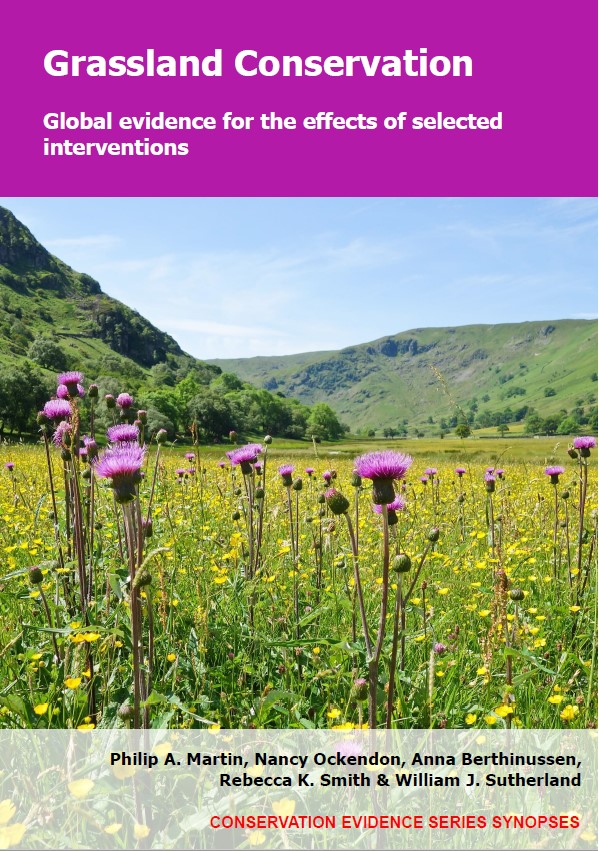Sow or plant nurse plants (alongside seeding/planting of grassland species)
-
Overall effectiveness category Evidence not assessed
-
Number of studies: 4
View assessment score
Hide assessment score
How is the evidence assessed?
-
Effectiveness
not assessed -
Certainty
not assessed -
Harms
not assessed
Study locations
Supporting evidence from individual studies
A replicated, paired, controlled study in 1992–1995 in five former prairie sites destroyed by road widening in Montana, USA (Tyser et al. 1998) found that sowing seeds of nurse plants alongside that of grassland species did not alter forb or grass cover. Cover of native forbs did not differ significantly between areas where nurse plant seeds were sown alongside seeds of grassland species (2.8–10.6%) and areas where seeds of grassland species were sown without nurse plant seeds (3.5–8.1%). The same pattern was true for non-native forbs (nurse: 3.8–21.4%; no nurse: 2.9–22.7%), native grasses (nurse: 7.8–10.0%; no nurse: 5.3–12.1%), and non-native grasses (nurse: 19.4–24.8%; no nurse: 14.1–29.1%). In summer 1992, after construction of a road, original topsoil was replaced at the five sites. In each site, two blocks containing two 8 × 4 m plots were established. In autumn 1992 or 1993, seeds of the nurse plant Triticum × Agropyron were sown with native seeds in one plot, and native seeds, but no nurse plant seed, was sown in one plot. In October 1992, all plots were sprayed with a mixture of wood mulch, tackifier, and nitrogen fertilizer. Vegetation cover of all species was estimated in July 1995 using five 50 × 20 cm quadrats in each plot.
Study and other actions testedA replicated, randomized, paired, controlled study in 2002–2003 in degraded rangelands in north central Kenya (King & Stanton 2008) found that planting buffel grass Cenchrus ciliaris beside aloe Aloe secundiflora nurse plants initially increased seedling survival, but after two to three years there was no increase. Two hundred and twenty days after planting, more grass seedlings planted next to aloe bushes were alive (16%) than those without nurse plants (6%). Survival of buffel grass seedlings in the second and third growing seasons after planting did not differ between seedlings next to nurse plants (84–100%) and those without nurse plants (95–100%). In April 2002, nine rows of 14 holes (14 cm diameter and 25 cm deep) were dug in bare ground. Mature aloe bushes were planted in seven holes in each row, and seven holes were refilled without planting aloe bushes. Buffel grass seeds (0.2 g) were sown in furrows 5 cm deep, 20 cm long and 10 cm away on either side of the rows of holes, and covered with soil. Seedling survival was monitored from April 2002–November 2003, which included three complete growing seasons.
Study and other actions testedA replicated, controlled study in 2006–2007 in arid steppe grassland in North-Eastern Spain (Pueyo et al. 2009) found that sowing seeds or planting under nurse plants increased survival of planted plants and increased seed germination. Survival of Salosa vermiculata and Lygeum spartum was higher when plants were planted under nurse plants (12–73%) than when they were not planted under nurse plants (0–93%). Seed germination of the two species was also higher (nurse plant: 0–21%; no nurse plant: 0–2%). In the planting experiment, in October 2006, twenty-five Salosa vermiculata and Lygeum spartum seedlings were planted four metres apart under mature Suaeda vera plants, while another twenty-five plants were planted without nurse plants. Seeding was carried out nearby to the seedling experiment (replication unclear). Survival of planted seedlings was recorded in February and September 2007. Seed germination was recorded in March, June and September 2007.
Study and other actions testedA replicated, controlled study in 1998–2003 on a newly-created motorway verge in southwestern Slovenia (Zelnik et al. 2010) found that plots sown with a seed mix containing nurse species contained a similar number of species, but the species composition was less similar to the target community compared to plots sown without nurse species. Three to five years after sowing, plots sown with seed mix with nurse species contained 18–22 species, compared to 24–30 species in plots without nurse species. The composition of plant species in plots sown with nurse species was less similar to the target dry grassland community (19–21%) than plots without nurse species (35–45%) (differences not subject to statistical tests). Vegetation cover was also lower in plots with nurse species than those without nurse species in one out of three years (69% vs 88%). Fifteen 3 x 3 m plots were established on new verges with a slope of approximately 30° constructed of topsoil. In June 1998, ten plots were sown with a mix of six competitive, stress-tolerant species. Five plots were sown with a mix of 12 species which contained ‘nurse’ grasses (Lolium species) and legumes (Trifolium species) in addition to the stress-tolerant species. Seeds were mixed with organic fertilizers, hay mulch, humic acids and water before seeding (hydroseeded). Plant species and cover were recorded in every plot each June. The target community was dry grassland adjacent to the new motorway.
Study and other actions tested
Where has this evidence come from?
List of journals searched by synopsis
All the journals searched for all synopses
This Action forms part of the Action Synopsis:
Grassland Conservation
Grassland Conservation - Published 2021
Grassland Synopsis





)_2023.JPG)














